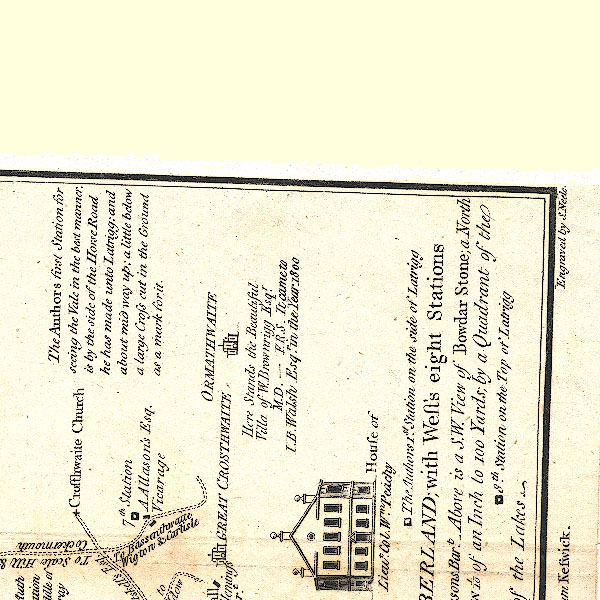




 Derwent Water
Derwent Waterplacename:- station, Derwent Water, West 8
 goto source
goto sourcePage 110:- "STATION VIII. Another station remains, and which ought to be an evening one, in the vicarage garden. Mr. Gray took it in his glass from the horsing-block, and speaks of it thus: 'From hence I got to the parsonage a little before sun-set, and saw in my glass a picture, that if I could transmit it to you, and fix it in all the softness of its living colours, would fairly sell for a thousand pounds. This is the sweetest scene I can yet discover, in"
 goto source
goto sourcePage 111:- "point of pastoral beauty; the rest are in sublimer style."
"The leading parts of this picture, are over a rich cultivated foreground, the town of Keswick seen under a hill, divided by grass inclosures, its summits crowned with wood. More to the east, Castle-rigg is sweetly laid out, and over it sweeps in curves the road to Ambleside. Behind that, are seen the range of vast mountains, descending from Helvellyn. On the western side, the chaos of mountains heaped upon mountains, that secrete the vale of Newland, make their appearance, and over them Cawsey-pike presides. Leaving these, the eye meets a well wooded hill, on the margin of the lake, shining in all the beauties of foliage, set off with every advantage of form. Next a noble expanse of water, broken just in the centre by a large island dressed in wood; another, cultivated and fringed with trees, and a third with a hut upon it, stript of its ornamental trees by the unfeeling hand of avarice [1]. On the eastern side, a bold shore, steep and wooded to the water's edge, is perceived, and above these, rise daring rocks in every horrid shape. Also, a strange mixture of wood"
"[1] This third is Vicar's island, which has since been purchased by a gentleman, who has built a large mansion, and made some other improvements upon it."
 goto source
goto sourcePage 112:- "and rock succeed one another to the southern extremity of the lake, where the grand pyramidal Castle-crag commands the whole. The western shore is indented with wooded promontories down to Foe-park, the hill first described, on the lower margin of the lake, and the mountains all around rise immediately from its edge, but those that form the outline to the south are very much broken, and hence more picturesque.- These parts of the scene, Mr. Gray says, are the sweetest he ever saw, in point of pastoral beauty. But whoever takes this view from Ormathwaite, in a field on the western side of the house, will be convinced of Mr. Gray's loss in want of information. For the very spot he stood upon there is in the centre of the fore-ground, and makes a principal object in the pastoral part of the picture he praises so highly."
 goto source
goto sourceAddendum; Mr Gray's Journal, 1769
Page 207:- "..."
"... I got to the parsonage a little before sun-set, and saw in my glass a picture, that if I could transmit to you, and fix it in all the softness of its living colours, would fairly sell for a thousand pounds. This is the sweetest scene I can yet discover in point of pastoral beauty; the rest are in a sublimer style."
placename:- station, Derwent Water, West 7

CT2NY22R.jpg
"7th. Station / A. Allason's Esq. / Vicarage"
By Allason's vicarage
item:- Armitt Library : 1959.191.3
Image © see bottom of page
item:- mounting block; horsing stone
 goto source
goto sourcePage 100:- "..."
"The other road which leads past the vicarage affords the grandest view for the artist of any in this country. Mr Gray describes it, but did not leave his road for it; and only viewed from the horsing-stone at the parsonage house: he says of it, "From hence I got to the parsonage a little before sunset, and saw in my glass a picture, that if I could transmit to you, and fix in all the softness of its living colours, would fairly sell for a thousand pounds. This is the sweetest scene that I can yet discover in point of pastoral beauty; the rest are in a sublimer stile." Here are two views, one facing Low-Door, and the other towards Finkle-street, which I think the better: to describe them is impossible, as they depend greatly upon the situation of the sun; for, according to the direction of his rays, the shades and tints are every moment varying, and in a cloudy day the landscape loses much of its beauty."
: West, Thomas
